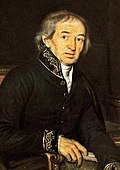Nikolay Lvov, Date of Birth, Place of Birth, Date of Death
TweetNikolay Lvov
Russian artist and architect
 Date of Birth: 04-May-1753
Date of Birth: 04-May-1753
 Place of Birth: Torzhok, Tver Oblast, Russia
Place of Birth: Torzhok, Tver Oblast, Russia
Date of Death: 22-Dec-1803
Profession: actor, composer, architect, poet, anthropologist, linguist
Zodiac Sign: Taurus 
About Nikolay Lvov
- Nikolay Aleksandrovich Lvov (May 4, 1753 – December 21, 1803) was a Russian artist of the Age of Enlightenment.
- Lvov, an amateur of Rurikid lineage, was a polymath who contributed to geology, history, graphic arts and poetry, but is known primarily as an architect and ethnographer, compiler of the first significant collection of Russian folk songs (the Lvov-Prach collection). Lvov's architecture represented the second, "strict" generation of neoclassicism stylistically close to Giacomo Quarenghi.
- Lvov worked in Saint Petersburg but his best works survived in the countryside, especially his native Tver Governorate.
- He redesigned the external appearance of Peter and Paul Fortress and created an unprecedented Trinity Church combining a Roman rotunda with one-of-a-kind pyramidal bell tower.
- He adapted rammed earth technology to the environment of Northern Russia and used it in his extant Priory Palace in Gatchina; Lvov's construction school, established in 1797, trained over 800 craftsmen.
- He managed geological surveys and published a treatise on the coals from Donets Basin and Moscow Basin.
- He experimented with coal pyrolysis, proposed new uses for coal tar and sulphur, and wrote a reference book on heating and ventilation. Lvov designed the badges of the Order of St.
- Vladimir and the Order of St.
- Anna, translated works by Anacreon, Palladio, Petrarch, Sappho and the Saga of King Harald into Russian language, wrote libretto for opera and vaudeville, researched Russian chronicles and published one of the first versions of the bylina of Dobrynya Nikitich.
- In 1783 he became one of the first 36 members of the Russian Academy. In 1931 Vladislav Khodasevich called Lvov "an intelligent and subtle connoisseur of everything ...
- who was not destined to do anything remarkable." Later researchers appreciated Lvov's contribution: Richard Taruskin considered Lvov's collection of folk songs "the greatest and most culturally significant of Russian folk collections", Philip Bohlman credited discovery of Russian folk art "all from the actions of a single individual, Lvov", William Craft Brumfield called Lvov "one of the greatest neoclassical architects produced in the reign of Catherine the Great...
- neoclassical aesthetics at its purest".
Read more at Wikipedia
See Also
- Famous People's Birthdays on 04 May, Russia
- Famous People's Birthdays in May, Russia
- Famous actor's Birthdays on 04 May, Russia
- Famous actor's Birthdays in May, Russia
- Famous composer's Birthdays on 04 May, Russia
- Famous composer's Birthdays in May, Russia
- Famous architect's Birthdays on 04 May, Russia
- Famous architect's Birthdays in May, Russia
- Famous poet's Birthdays on 04 May, Russia
- Famous poet's Birthdays in May, Russia
- Famous anthropologist's Birthdays on 04 May, Russia
- Famous anthropologist's Birthdays in May, Russia
- Famous linguist's Birthdays on 04 May, Russia
- Famous linguist's Birthdays in May, Russia


